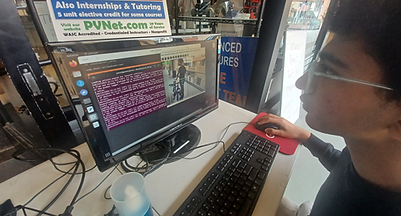


AI E-Bike Detection System
2025 EXPLORATORY INTERNSHIP PROJECT

AI E-Bike Detection System Abstract
*Draft - Development In Process
Team Memebers
-
Anh Nguyen – Project Lead, Main Programmer
-
Liam Matthews – Programmer, Innovative Problem Solver, AI Specialist
-
Nicolas Akerlof – Main Organizer, Test Dummy, Programmer
-
Max Rubinstein – Programmer, Problem Solver
-
Vansh Gandhi – Programmer
Goal / Introduction
The objective of this project is to design and build a wireless, low-light-capable, AI-powered detection system that identifies individuals riding bicycles, e-bikes, scooters, or skateboards in restricted areas. The system provides real-time alerts to security personnel through SMS and email, enhancing perimeter control and public safety. Core hardware includes the Jetson Orin Nano Developer Kit in a cooling case, enabling on-device video processing without reliance on cloud infrastructure.
Methodology
The team initially planned to collect and annotate a custom dataset in Roboflow, labeling classes such as bike_rider, scooter_rider, and skateboard_rider. Using tools like Grounding DINO, the target was 400–500 images per class for training a YOLOv8 model. However, after experimentation, pre-trained YOLOv8 models were found to be sufficient, significantly reducing development time. The system was implemented on a Jetson Orin Nano with NVMe SSD storage for improved performance, Wi-Fi connectivity for alert delivery, and GPU-based inference for real-time detection.
Development involved overcoming several setup challenges, including hardware misconfiguration, incorrect flashing procedures, and reliance on unsupported Jetson devices. A particular difficulty was finding a fully compatible CSI camera module, which delayed progress until the correct hardware and configuration were identified. These issues were ultimately resolved through careful documentation review, correct wiring, and configuring the system with Ubuntu 20.04 for flashing and GPU acceleration.
Results
The system is operational and capable of detecting riders in restricted areas with reasonable accuracy. Lighting conditions were found to significantly impact detection reliability, requiring further optimization for low-light environments. Additionally, a simplified version of the software that exclusively detects bicycles has been created for use in parks where bikes are prohibited. This specialized system is expected to be deployed in the near future.
Conclusion
This project demonstrates the feasibility of an AI-powered edge detection system for monitoring restricted zones. While current performance is promising, future work will focus on improving detection in challenging lighting conditions, refining real-time alert capabilities, and scaling deployment for both general-purpose and bike-specific use cases.

Gallery
*In Process
_heic.png)
_heic.png)
_heic.png)
_heic.png)
_heic.png)
_heic.png)
_heic.png)





